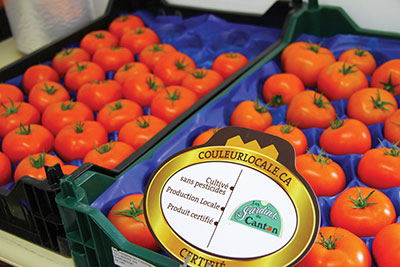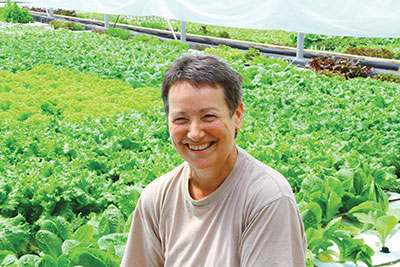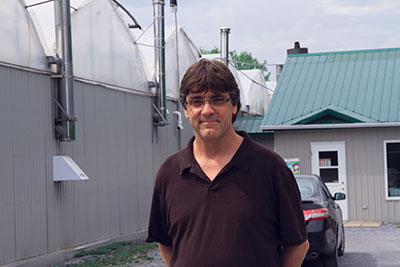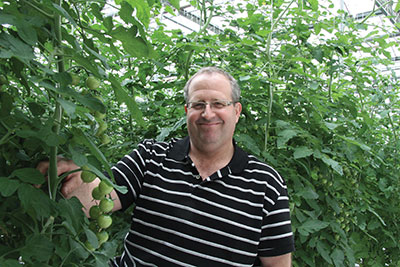
The main entrance to Les Jardins du Canton’s greenhouses is a tiny shop, where shelves never stay full for very long.
The main entrance to Les Jardins du Canton’s greenhouses is a tiny shop, where shelves never stay full for very long. The lettuce, tomatoes and cucumbers are picked and sold within hours.
 |
|
| Certified Couleur Locale. PHOTOS BY ANDRé DUMONT Advertisement
|
“When we started in 1997,” says founder and co-owner Denise Poutré, “we expected to sell 10 per cent of our crop to consumers dropping by. We are now at 55 per cent.”
Located in Bedford, in Quebec’s Eastern Townships, the 1,500-square-metre complex is not the typical state-of-the-art, large-scale operation you are used to reading about. This one is small, diversified and its owners actually do some of the picking. They have access to specialized agronomist services and use any available up-to-date technology to prevent disease and insect problems.
Direct sales to consumers and to a few local supermarkets explain part of the success at Les Jardins du Canton.
But there is another secret: the operation Poutré runs is part of a club, just like 74 other small- and medium-size greenhouse operations in Quebec, the largest one barely exceeding 5,000 square metres. Through the Club Savoir-Serre, they obtain regular agronomist advice.
CERTIFICATION PROGRAM LAUNCHED FOR GROWERS
Over time, the club has ventured beyond technical support and into group supply purchases. It has recently established a certification program that reflects just what its members are about: providing locally grown, tasty and healthy produce to area consumers.
 |
|
| Denise Poutré launched Les Jardins du Canton along with co-owners Thérèse Poutréand Gilbert Otis. |
“Between the farmer and the consumer, there is usually less than 36 hours,” says agronomist Jacques Thériault, who has been with the club since its inception. “While those who supply wholesale markets need to focus on conservation, we can focus on taste.”
The club’s first steps came in 1999, when the Réseau d’expertise en serriculture maraîchère (greenhouse production knowledge network) was started. Producers could attend six seminars annually. It soon became clear that the real need was for individual, onsite professional advice.
“Everyone has a different setup,” Poutré says.
PROVINCE ASSISTS WITH MEMBERSHIP FEES
In 2002, the club started operating on the model of Quebec’s agro-environmental clubs that provide agronomy services to farmers in cash crop and animal operations. Membership fees are split between producers and the provincial government.
 |
|
| Agronomist Claude Thériault has been with Club Savoir-Serre since its inception.
|
In the case of Club Savoir-Serre, the focus was clearly on production, in order to help smaller greenhouse growers who could not afford to hire agronomists.
“For producers of my size, the club was a real springboard. Over the last 10 years, I was able to double my output and the quality of my product is much better,” says Luc Verrier, who grows tomatoes, lettuce and cucumbers in 2,500 square metres of greenhouses near Drummondville.
Today, the group has three full-time agronomists. One of them visits Verrier every 14 days. “Our agronomists travel across the province and they know all the other growers,” he says. “Sometimes I think I’m the only one with a problem, but it turns out some other growers have already dealt with the same issue.”
For Poutré, who graduated from ag school at age 40 after a career in farm media, the club was a welcome relief when she started farming. “We felt isolated,” she says. “We didn’t know anybody in the greenhouse business.”
GROUP PURCHASING POWER HELPS LOWER INPUT COSTS
In 2006, the club started organizing group purchases, in order for its members to obtain better prices for fertilizer, growing media and seed. That same year, members started to receive coaching to diversify their production. There was an opportunity to sell a greater variety of produce to each member’s existing clientele.
 |
|
| Since joining Club Savoir-Serre, grower Luc Verrier has doubled the output of his greenhouses.
|
Today, Poutré produces mostly tomatoes, cucumbers and lettuce. But each of her six greenhouses has at least one row of peppers, eggplants, green string beans or melons. “Melons are not the most profitable crop, but they are fun to grow and they never stay long on the shelves.”
In 2009, Jacques Thériault had another idea for the club: creating a label that would help members in marketing their products. Two years later, Couleur Locale was born and Les Jardins du Canton became one the first members to receive certification. At the time of our interview, 11 of the 75 members of Club Savoir-Serre had become certified.
“There are lot of certifications out there, but this is the only one that targets specifically the consumers’ expectations of freshness and taste, with a guarantee that it’s grown by someone near you,” Thériault says.
The Couleur Locale (Local Colour) label guarantees the produce was grown locally or less than 80 kilometres away from the point of purchase. In large regions like Abitibi, the produce may travel beyond 80 km, as long as it does not come from another administrative region.
PESTICIDE-FREE PRODUCE ASSURANCE FOR CONSUMERS
Couleur Locale also means no synthetic pesticides were used. “There is not only organic and non-organic out there,” Thériault says. “Our certified members are monitored and they have to use greenhouse technologies that make it possible for them never to use chemical pesticides.”
Taste and freshness are also promoted, because the produce is picked only when ripe. Farmers cater to local preferences and use consumer feedback to select varieties.
There are several technical requirements to become certified. By the second year, any certified member must also obtain the CanadaGAP certification, even though traceability is not a major issue when produce is sold onsite or delivered directly to the food outlet by the producer.
Those who seek Couleur Local certification must prove they own and personally operate their greenhouses. The owner must be the one overseeing production, biosecurity, pest and disease control, and delivery to the point of sale. Hiring a farm manager, outsourcing transportation and selling to wholesale outlets is not permitted.
GOAL IS TO INCREASE NUMBER OF CERTIFIED MEMBERS
The next step for Club Savoir-Serre is to transfer the certification process to an external agency. So far, it seems that using organic certifiers for non-organic certification may not be the best option. The club is also seeking to certify more of its 75 members. There is no intention to lower requirements in order for all to be certified.
At Les Jardins du Canton, the certification is used to reinforce the farm’s relationship with its existing clientele.
“Some clients already knew that I don’t use pesticides, but now I have proof. I’m certified,” Poutré says.
At Frelighsburg’s Marché Gosselin Tradition, the Couleur Locale signs are welcome. The small supermarket has an upscale cottage country clientele that demands local products.
Producer Luc Verrier says the 12 grocery stores, convenience stores and other food outlets he serves were already quite reassured by his pesticide-free production methods.
“Now, no one can doubt what I say,” he says. “I know that because of Couleur Locale, some grocers have given priority to my products.”
• www.couleurlocale.ca
André Dumont is a freelance writer and photographer in Montreal.
Print this page